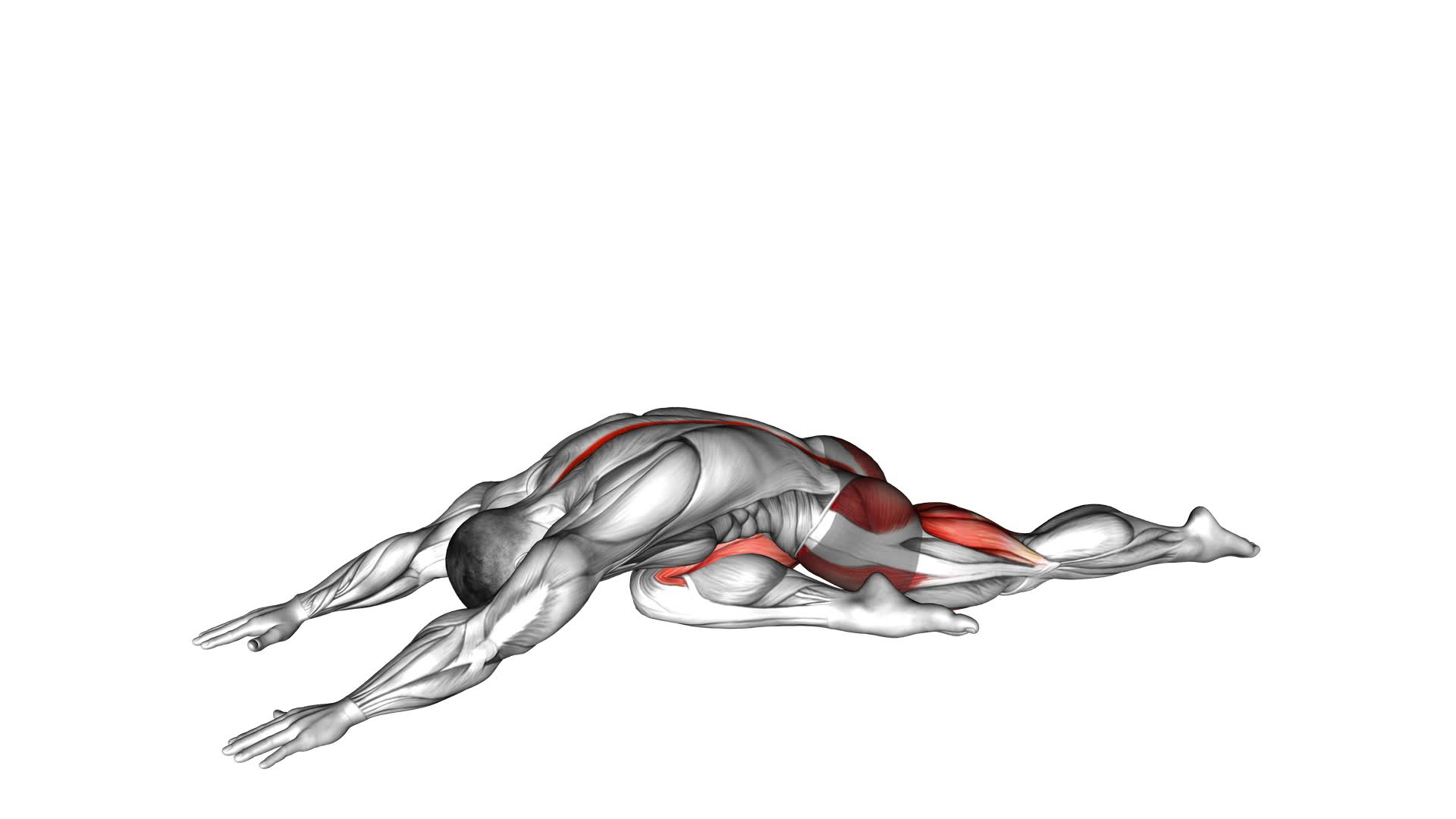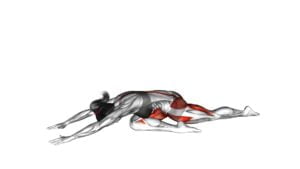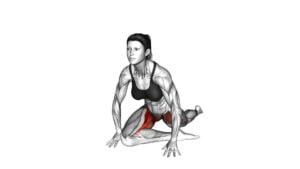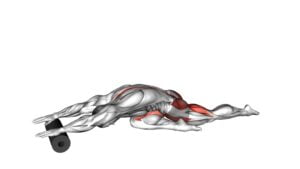Pigeon Hip Stretch – Video Exercise Guide & Tips

Are you looking for a simple and effective way to stretch your hips? Look no further than the Pigeon Hip Stretch!
Watch This Exercise Video
In this video exercise guide, we'll show you the proper form and technique to get the most out of this stretch. Whether you're a beginner or a seasoned athlete, we've got modifications and variations to suit your fitness level.
Avoid common mistakes and maximize the benefits of your routine with our expert tips.
Let's dive in and improve your hip flexibility today!
Key Takeaways
- Pigeon hip stretch improves hip mobility and flexibility.
- Pigeon hip stretch helps alleviate lower back pain.
- Pigeon hip stretch enhances athletic performance and prevents injuries.
- Pigeon hip stretch increases blood flow to the hip area and reduces muscle tension and tightness.
Benefits of the Pigeon Hip Stretch
One benefit of the Pigeon Hip Stretch is that it can help alleviate tightness and improve flexibility in your hips. The Pigeon Hip Stretch is a versatile exercise that offers variations to target different areas of the hips and promote flexibility and mobility. By practicing different variations of the Pigeon Hip Stretch, you can effectively stretch and strengthen the muscles in your hips, including the glutes, hip flexors, and piriformis.
The Pigeon Hip Stretch variations allow you to adjust the intensity and focus of the stretch according to your individual needs and goals. For example, the classic Pigeon pose targets the glutes and hip flexors, while the reclined Pigeon pose provides a more gentle stretch for those with limited flexibility. Additionally, you can modify the angle and position of your front leg to target specific areas of tightness.
Incorporating the Pigeon Hip Stretch into your regular routine can lead to improved flexibility and mobility in your hips, which can have a positive impact on your overall movement and athletic performance. It can also help alleviate tightness and discomfort caused by prolonged sitting or physical activities that put stress on the hip joints.
Transitioning into the subsequent section about proper form and technique for the Pigeon Hip Stretch, it's important to understand how to execute the exercise correctly to maximize its benefits and prevent injury.
Proper Form and Technique for the Pigeon Hip Stretch
To properly execute the Pigeon Hip Stretch, follow these guidelines for correct form and technique.
Hip flexibility is crucial for overall mobility and range of motion. The Pigeon Hip Stretch is a highly effective exercise that targets the hip muscles and helps improve flexibility in that area. Incorporating this stretch into your yoga practice can provide numerous benefits.
Start by positioning yourself on all fours, with your hands directly under your shoulders and your knees under your hips. Bring your right knee forward and place it behind your right wrist. Your right foot should be near your left hip. Slowly slide your left leg back, extending it straight behind you. Keep your hips squared and your back straight.
As you settle into the stretch, focus on relaxing your body and breathing deeply. You should feel a gentle stretch in the right hip area. If you feel any pain, modify the position by placing a block or a folded blanket under your right hip for support.
Incorporating the Pigeon Hip Stretch into your yoga practice can help improve hip flexibility, which is essential for various yoga poses and movements. This stretch can also alleviate tightness and discomfort in the hips caused by prolonged sitting or physical activity. Remember to always listen to your body and adjust the stretch as needed.
Modifications and Variations for Different Fitness Levels
For different fitness levels, there are several modifications and variations available for the Pigeon Hip Stretch. Whether you're a beginner looking for modifications or an advanced practitioner seeking variations, there are options to suit your needs and abilities.
For beginners, here are some modifications to make the Pigeon Hip Stretch more accessible:
- Use a prop: Place a folded blanket or yoga block under your hip to elevate it slightly and reduce the intensity of the stretch.
- Limit the range of motion: Instead of bringing your front leg parallel to the front of the mat, keep it bent and closer to your body. This will decrease the stretch intensity.
On the other hand, if you're more advanced and want to challenge yourself, you can try these variations:
- Extended arm reach: As you fold forward, reach your arms straight out in front of you, lengthening your spine and intensifying the stretch in your hips and glutes.
- Thread the needle: From the pigeon position, bend your back leg and reach your opposite arm through the space between your front thigh and calf. This variation adds a twist and targets the outer hip and glute muscles.
Common Mistakes to Avoid During the Pigeon Hip Stretch
Avoid these common mistakes during the Pigeon Hip Stretch to maximize its effectiveness and prevent injury. Proper technique is crucial to ensure that you're getting the most out of this stretch and avoiding any potential harm.
One of the most common mistakes isn't properly aligning your front knee. Make sure that your knee is directly above your ankle, forming a 90-degree angle. This will help to protect your knee joint and ensure that the stretch is targeting the hip muscles effectively.
Another common mistake is rounding the back. It's important to keep your back straight and avoid hunching over during the stretch. This will help to maintain proper alignment and prevent strain on the lower back.
Additionally, avoid putting too much weight on your front leg. The stretch should primarily be felt in the hip of the back leg. Placing excessive pressure on the front leg can lead to strain and discomfort.
Tips for Getting the Most Out of Your Pigeon Hip Stretch Routine
To maximize the benefits of your Pigeon Hip Stretch routine, follow these tips for optimal results:
- Warm-up: Before starting your Pigeon Hip Stretch routine, it's crucial to warm up your body. Engage in light cardio exercises such as jogging or cycling for five to ten minutes. This will increase blood flow to your muscles and prepare them for stretching, improving flexibility.
- Proper Alignment: Pay attention to your body alignment during the Pigeon Hip Stretch. Make sure your front knee is at a 90-degree angle and in line with your ankle. Keep your back leg straight and aligned with your hip. Maintaining proper alignment will maximize the effectiveness of the stretch and prevent any strain or injury.
- Gradual Progression: Start with the basic Pigeon Hip Stretch and gradually increase the intensity and duration as your flexibility improves. Push yourself gently but avoid pushing beyond your limit to prevent injury. Consistency is key in maximizing the effectiveness of your routine.
- Breathing Technique: Focus on your breathing while performing the Pigeon Hip Stretch. Take deep breaths in through your nose and exhale slowly through your mouth. This will help relax your muscles and deepen the stretch, enhancing its effectiveness.
Frequently Asked Questions
How Often Should I Perform the Pigeon Hip Stretch?
To get the most out of the pigeon hip stretch, it's important to consider frequency. How often you should perform the stretch depends on your goals and current fitness level.
The pigeon hip stretch provides numerous benefits, such as increased hip flexibility and reduced tightness. However, it's essential to listen to your body and not overdo it.
Start with a few times a week and gradually increase the frequency as your body allows.
Can the Pigeon Hip Stretch Help With Lower Back Pain?
The pigeon hip stretch is a great exercise to relieve lower back pain. By stretching the hips, it helps alleviate tension in the lower back muscles.
The pigeon hip stretch also has variations that target different areas of the hip and can be adjusted to your comfort level.
In addition to reducing lower back pain, this stretch can improve your overall posture by increasing flexibility and mobility in the hips and pelvis.
Is It Normal to Feel Discomfort During the Pigeon Hip Stretch?
It's completely normal to feel some discomfort during the pigeon hip stretch. This stretch targets the hip flexor muscles, which can be tight and cause discomfort.
However, if the discomfort is too intense or sharp, it's important to modify the stretch or adjust your form to avoid any potential injury.
Proper form for the pigeon hip stretch and modifications can help alleviate discomfort and ensure a safe and effective stretch.
Can the Pigeon Hip Stretch Improve Flexibility in Other Areas of the Body?
Improving flexibility in other areas of your body is one of the benefits of the pigeon hip stretch. This stretch targets your hips, glutes, and lower back, but it can also help to increase flexibility in your hamstrings and hip flexors.
For runners, this can be especially beneficial as it can improve stride length and reduce the risk of injury.
Beginners can modify the pigeon hip stretch by using props like a yoga block or cushion to support their hips and make the stretch more accessible.
Are There Any Contraindications or Precautions for Performing the Pigeon Hip Stretch?
When it comes to the pigeon hip stretch, it's important to know about any contraindications or precautions before performing the exercise. Understanding these factors can help you avoid any potential risks or injuries.
Make sure to consult with a healthcare professional if you have any specific concerns or conditions that may affect your ability to safely perform the stretch. Taking the necessary precautions and being aware of any contraindications can help ensure a safe and effective workout.
Conclusion
In conclusion, the pigeon hip stretch is an effective exercise for improving flexibility and mobility in the hips. By practicing proper form and technique, individuals can experience the benefits of this stretch, such as reduced hip tightness and improved posture.
It's important to listen to your body and make modifications based on your fitness level. Avoid common mistakes and follow the tips provided to get the most out of your pigeon hip stretch routine.

Author
Years ago, the spark of my life’s passion ignited in my mind the moment I stepped into the local gym for the first time. The inaugural bead of perspiration, the initial endeavor, the very first surge of endorphins, and a sense of pride that washed over me post-workout marked the beginning of my deep-seated interest in strength sports, fitness, and sports nutrition. This very curiosity blossomed rapidly into a profound fascination, propelling me to earn a Master’s degree in Physical Education from the Academy of Physical Education in Krakow, followed by a Sports Manager diploma from the Jagiellonian University. My journey of growth led me to gain more specialized qualifications, such as being a certified personal trainer with a focus on sports dietetics, a lifeguard, and an instructor for wellness and corrective gymnastics. Theoretical knowledge paired seamlessly with practical experience, reinforcing my belief that the transformation of individuals under my guidance was also a reflection of my personal growth. This belief holds true even today. Each day, I strive to push the boundaries and explore new realms. These realms gently elevate me to greater heights. The unique combination of passion for my field and the continuous quest for growth fuels my drive to break new ground.







